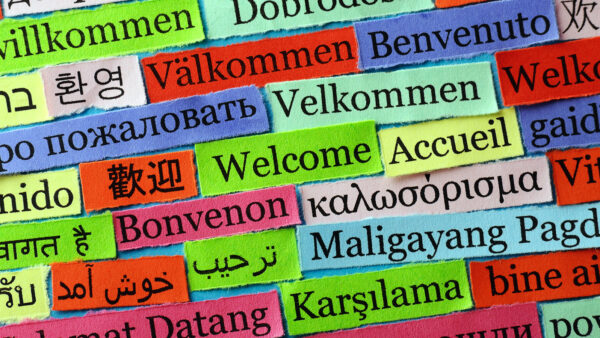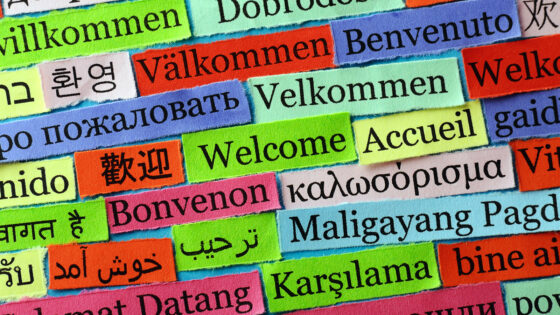
Search drives 68% of trackable traffic, far exceeding all other marketing channels–including display and social media. It’s no surprise that a well-planned search engine optimization (SEO) strategy is the key to online success.
Yet developing one can be tricky and that’s because it requires an understanding of the user’s search intent in the target language and tailoring web content to match it. To attract the right customers, you need to create a multilingual SEO strategy for each market you’re targeting.
This blog post will walk you through the five crucial steps to creating a successful SEO search marketing strategy.
The benefits of multilingual SEO
Multilingual SEO is the practice of optimizing web content for multiple languages. It’s an essential part of an SEO localization strategy that includes adapting keywords, content, and website structure. Multilingual SEO improves your localized website’s ranking in the target market and drives more relevant traffic, which increases your sales conversion rate.
Optimizing for Google is an obvious step, as it has over 81% of the global market share. But you may also need to consider search engines commonly used in your target markets. In China, for example, Baidu is the most popular search engine. And in Russia, it’s Yandex. To reach the largest audience in your target market, follow SEO best practices for the most popular search engine in the region.
Why develop a multilingual SEO strategy?
Like any multilingual marketing effort, you need a multilingual SEO roadmap to guide content strategy. It takes more than translating keywords to achieve the results you want. You need to conduct keyword research in the target language to identify relevant search terms and phrases and adapt the content to ensure it reaches the right audience.
While this requires expertise in the target language and SEO, the right strategy offers multiple business benefits. Here’s an overview of four of them.
Increase search visibility, web traffic, and international brand awareness
A well-executed SEO strategy can help improve your rankings in multilingual search results. This increases your localized site’s visibility, and in turn, web traffic. Multilingual SEO can even improve brand awareness through the use of consistent keywords and messaging across online campaigns.
Engage audiences in their native language for better results
A Common Sense Advisory (CSA) research study found that 76% of consumers prefer to buy products with information in their own language. And 40% will never buy from websites in other languages.
By implementing multilingual SEO, you’ll attract audiences that prefer content in their local language. It shows them that you respect local user experience and cultural preferences. This makes visitors more likely to place more trust in your website and brand.
Gain a competitive advantage
Nearly 52% of all websites are in English. That means simply translating your website can give you a competitive edge. Multilingual SEO helps capitalize on that advantage by increasing your online visibility in the target market.
Reduce customer acquisition cost (CAC)
Multilingual SEO is among the most cost-effective ways to attract global customers. Case in point, SEO can reduce acquisition cost by as much as 87% compared to digital advertising. Why? Because once you optimize your website for multiple markets, it continues to attract organic traffic and generates leads over time.
Implementing a multilingual SEO strategy: 5 steps for success
Now that you know the business benefits of a multilingual SEO strategy, let’s look at how to create one. Here are five steps for success.
Identify your key target markets for search visibility
Consider international markets that have a high demand for your products or services. You can use SEO tools such as Ahrefs and Semrush’s Market Explorer to track search trends. These tools also help you identify which countries your competitors are in, presenting you with new business opportunities. From there, you can delve deeper into a particular market by conducting a competitive analysis and more extensive market research.
Additionally, AI can help with keyword research and streamline content adaption for different markets’ search trends. This can boost efficiency in ensuring the localized content is optimized for SEO with appropriate keyword usage and meta-data for each language and region.
Conduct keyword research for each target language
Work with qualified, native linguists to help you brainstorm keywords for the target markets. This list will serve as a guide to help you choose more relevant keywords. Then you can use a keyword research tool to expand on the seed keyword list and gather metrics such as search volume and keyword difficulty.
Optimize your multilingual website’s URL structure
You need dedicated URLs for each language and country version of your website. There are three ways to do this: separate domains, subfolders, and subdomains.
Here’s an overview of each:
- Separate domains (ccTLDs). Many multilingual websites use a ccTLD like .uk or .fr. For example, a French URL looks like this: abcwebsite.fr.
This option requires maintaining domains for each country and building links to each domain individually. It’s technically challenging and time-consuming from an SEO perspective. However, it gives you the ability to use localized hosting, which can improve page load times.
- Subfolders. This is another popular option. It involves creating a subfolder for each language and creating individual pages within it. For example, a Spanish URL looks like this: abcwebsite.com/es/.
It’s easier than rolling out subfolders and pages on a different hosting setup. However, you can’t use localized hosting.
- Language subdomains. Subdomains allow you to use one domain for all languages, with separate subdomains for each language. For example, a German URL looks like this: de.abcwebsite.com.
Like ccTLDs, subdomains are complicated to set up and maintain. Additionally, SEO experts believe that Google treats subdomains as separate domains. That means you may need to build SEO authority for multiple domains instead of a single, primary one. However, it does give you the ability to localize hosting to improve page speed.
Use Hreflang to target languages and locations
An hreflang is an HTML attribute that tells search engines the location and geographical targeting of a webpage. It helps Google and Yandex serve the right language version of your website in search results. To implement hreflang tags:
- Place them in the <head> section of each page
- Use the correct ISO 639-1 language code for the target country
- Use self-referencing hreflang tags on every page. This tells the search engine that other language versions are also available
Please note that Bing and Baidu don’t fully support hreflang tags. To optimize for these search engines, use the content-language tag in the page’s <head> section. This tells Baidu and Bing which language is on the page. For example, the U.S. English tag looks like this: <meta http-equiv=“content-language content=“en-us>.
AI-driven tools can automate the creation and insertion of hreflang tags, improving accuracy and efficiency for hreflang implementation. Leveraging these kinds of tools reduces the risk of duplicate content penalties and helps improve search visibility in target regions.
Build backlinks using websites in the target language
An SEO strategy is incomplete without backlinks. That’s because backlinks help you demonstrate credibility and improve your ranking in the search results. The majority of backlinks should be from relevant websites—both in niche and target language. Aim to build links from high-authority websites such as industry publications and news outlets.
A few backlinking strategies include:
- Competitor backlink analysis. Research your competitors’ backlinks to gain insight into the content types that acquire links in your industry.
- Broken link building. Find broken links on relevant websites. Then contact the owners and suggest replacing them with a link to your website.
- Digital PR. Pitch stories about your brand to get online media coverage. The news article will typically include a link to your website.
AI can help identify opportunities for link building by analyzing backlink profiles and suggesting potential sources for backlinks in different languages and regions.
Reach new markets with Acclaro’s multilingual SEO solutions
Multilingual SEO plays a crucial role in successful localization for international expansion. But it does require technical know-how to get it right. Fortunately, you don’t have to do it alone. Acclaro offers the multilingual SEO services you need to expand your global presence.
We work with you to develop a unique multilingual SEO strategy that addresses your business goals. From multilingual website architecture and content translation to keyword strategies and maximizing your budget, we help you manage every step of the process.
Get started today to learn more about how Acclaro can transform your multilingual website into a customer magnet.
Insights for global growth






Power your strategic growth
Go beyond tactical localization with tailored, strategic solutions that resonate locally and drive growth globally.
Get started
